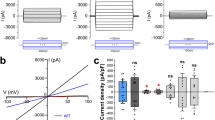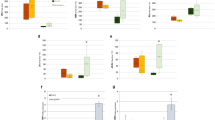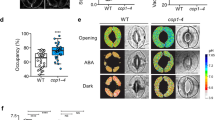Abstract
Stomatal pores, formed by two surrounding guard cells in the epidermis of plant leaves, allow influx of atmospheric carbon dioxide in exchange for transpirational water loss. Stomata also restrict the entry of ozone — an important air pollutant that has an increasingly negative impact on crop yields, and thus global carbon fixation1 and climate change2. The aperture of stomatal pores is regulated by the transport of osmotically active ions and metabolites across guard cell membranes3,4. Despite the vital role of guard cells in controlling plant water loss3,4, ozone sensitivity1,2 and CO2 supply2,5,6,7, the genes encoding some of the main regulators of stomatal movements remain unknown. It has been proposed that guard cell anion channels function as important regulators of stomatal closure and are essential in mediating stomatal responses to physiological and stress stimuli3,4,8. However, the genes encoding membrane proteins that mediate guard cell anion efflux have not yet been identified. Here we report the mapping and characterization of an ozone-sensitive Arabidopsis thaliana mutant, slac1. We show that SLAC1 (SLOW ANION CHANNEL-ASSOCIATED 1) is preferentially expressed in guard cells and encodes a distant homologue of fungal and bacterial dicarboxylate/malic acid transport proteins. The plasma membrane protein SLAC1 is essential for stomatal closure in response to CO2, abscisic acid, ozone, light/dark transitions, humidity change, calcium ions, hydrogen peroxide and nitric oxide. Mutations in SLAC1 impair slow (S-type) anion channel currents that are activated by cytosolic Ca2+ and abscisic acid, but do not affect rapid (R-type) anion channel currents or Ca2+ channel function. A low homology of SLAC1 to bacterial and fungal organic acid transport proteins, and the permeability of S-type anion channels to malate9 suggest a vital role for SLAC1 in the function of S-type anion channels.
This is a preview of subscription content, access via your institution
Access options
Subscribe to this journal
Receive 51 print issues and online access
$199.00 per year
only $3.90 per issue
Buy this article
- Purchase on Springer Link
- Instant access to full article PDF
Prices may be subject to local taxes which are calculated during checkout




Similar content being viewed by others
Accession codes
Primary accessions
ArrayExpress
Data deposits
The primary microarray data reported has been deposited with the ArrayExpress database under accession number E-MEXP-1388.
References
Hopkin, M. Carbon sinks threatened by increasing ozone. Nature 448, 396–397 (2007)
Sitch, S., Cox, P. M., Collins, W. J. & Huntingford, C. Indirect radiative forcing of climate change through ozone effects on the land-carbon sink. Nature 448, 791–794 (2007)
MacRobbie, E. A. C. Signal transduction and ion channels in guard cells. Phil. Trans. R. Soc. Lond. B 353, 1475–1488 (1998)
Hetherington, A. M. & Woodward, F. I. The role of stomata in sensing and driving environmental change. Nature 424, 901–908 (2003)
Webb, A. A. R. & Hetherington, A. Convergence of the abscisic acid, CO2, and extracellular calcium signal transduction pathways in stomatal guard cells. Plant Physiol. 114, 1557–1560 (1997)
Young, J. J. et al. CO2 signaling in guard cells: calcium sensitivity response modulation, a Ca2+ -independent phase, and CO2 insensitivity of the gca2 mutant. Proc. Natl Acad. Sci. USA 103, 7506–7511 (2006)
Hashimoto, M. et al. Arabidopsis HT1 kinase controls stomatal movements in response to CO2 . Nature Cell Biol. 8, 391–397 (2006)
Schroeder, J. I. & Hagiwara, S. Cytosolic calcium regulates ion channels in the plasma membrane of Vicia faba guard cells. Nature 338, 427–430 (1989)
Schmidt, C. & Schroeder, J. I. Anion-selectivity of slow anion channels in Vicia faba guard cells: large nitrate permeability. Plant Physiol. 106, 383–391 (1994)
Pandey, S., Zhang, W. & Assmann, S. M. Roles of ion channels and transporters in guard cell signal transduction. FEBS Lett. 581, 2325–2336 (2007)
Keller, B. U., Hedrich, R. & Raschke, K. Voltage-dependent anion channels in the plasma membrane of guard cells. Nature 341, 450–453 (1989)
De Angeli, A. et al. The nitrate/proton antiporter AtCLCa mediates nitrate accumulation in plant vacuoles. Nature 442, 939–942 (2006)
Overmyer, K. et al. Ozone-sensitive Arabidopsis rcd1 mutant reveals opposite roles for ethylene and jasmonate signaling pathways in regulating superoxide-dependent cell death. Plant Cell 12, 1849–1862 (2000)
Kangasjärvi, J., Jaspers, P. & Kollist, H. Signalling and cell death in ozone-exposed plants. Plant Cell Environ. 28, 1021–1036 (2005)
Kollist, T. et al. A novel device detects a rapid ozone-induced transient stomatal closure in intact Arabidopsis and its absence in abi2 mutant. Physiol. Plant. 129, 796–803 (2007)
Camarasa, C. et al. Characterization of Schizosaccharomyces pombe malate permease by expression in Saccharomyces cerevisiae. Appl. Environ. Microbiol. 67, 4144–4151 (2001)
Sasaki, T. et al. A wheat gene encoding an aluminum-activated malate transporter. Plant J. 37, 645–653 (2004)
Zimmermann, P., Hirsch-Hoffmann, M., Hennig, L. & Gruissem, W. GENEVESTIGATOR: Arabidopsis microarray database and analysis toolbox. Plant Physiol. 136, 2621–2632 (2004)
Xie, X. et al. The identification of genes involved in the stomatal response to reduced atmospheric relative humidity. Curr. Biol. 16, 882–887 (2006)
McAinsh, M. R., Brownlee, C. & Hetherington, A. M. ABA induced elevation of guard cell cytosolic calcium precedes stomatal closure in Commelina communis. Nature 343, 186–188 (1990)
Pei, Z. M. et al. Calcium channels activated by hydrogen peroxide mediate abscisic acid signalling in guard cells. Nature 406, 731–734 (2000)
Desikan, R., Griffiths, R., Hancock, J. & Neill, S. A new role for an old enzyme: Nitrate reductase-mediated nitric oxide generation is required for abscisic acid-induced stomatal closure in Arabidopsis thaliana. Proc. Natl Acad. Sci. USA 99, 16314–16318 (2002)
Allen, G. J. et al. A defined range of guard cell calcium oscillation parameters encodes stomatal movements. Nature 411, 1053–1057 (2001)
Li, Y. et al. The parameters of guard cell calcium oscillation encode stomatal oscillation and closure in Vicia faba. Plant Sci. 166, 415–421 (2004)
Mori, I. C. et al. CDPKs CPK6 and CPK3 function in ABA regulation of guard cell S-type anion- and Ca2+-permeable channels and stomatal closure. PLoS Biol. 4, 1749–1762 (2006)
Van Kirk, C. A. & Raschke, K. Release of malate from epidermal strips during stomatal closure. Plant Physiol. 61, 474–475 (1978)
MacRobbie, E. A. C. Ion fluxes in ‘isolated’ guard cells of Commelina communis L. J. Exp. Bot. 32, 545–562 (1981)
Frachisse, J. M., Thomine, S., Colcombet, J., Guern, J. & Barbier-Brygoo, H. Sulfate is both a substrate and an activator of the voltage-dependent anion channel of Arabidopsis hypocotyl cells. Plant Physiol. 121, 253–261 (1999)
Suh, S. J. et al. The ATP binding cassette transporter AtMRP5 modulates anion and calcium channel activities in Arabidopsis guard cells. J. Biol. Chem. 282, 1916–1924 (2007)
Linder, B. & Raschke, K. A slow anion channel in guard cells, activating at large hyperpolarization, may be principal for stomatal closing. FEBS Lett. 313, 27–30 (1992)
Leonhardt, N. et al. Microarray expression analyses of Arabidopsis guard cells and isolation of a recessive ABA hypersensitive protein phosphatase 2C mutant. Plant Cell 16, 596–615 (2004)
Yang, Y., Costa, A., Leonhardt, N., Siegel, R. S. & Schroeder, J. I. Isolation of a strong Arabidopsis guard cell promoter and its potential as a research tool. BMC Pl. Methods (in the press)
Curtis, M. D. & Grossniklaus, U. A gateway cloning vector set for high-throughput functional analysis of genes in Planta. Plant Physiol. 133, 462–469 (2003)
Clough, S. J. & Bent, A. F. Floral dip: a simplified method for Agrobacterium-mediated transformation of Arabidopsis thaliana. Plant J. 16, 735–743 (1998)
Weigel, D. & Glazebrook, J. Arabidopsis: A Laboratory Manual (Cold Spring Harbor Laboratory Press, Cold Spring Harbor, New York, 2002)
Suntio, T. M. & Teeri, T. H. A new bifunctional reporter gene for in-vivo tagging of plant promoters. Plant Mol. Biol. Rep. 12, 43–57 (1994)
Allen, G. J., Chu, S. P. & Schroeder, J. I. A defined range of guard cell calcium oscillation parameters encodes stomatal movements. Nature 411, 1053–1057 (2001)
Murata, Y., Pei, Z. M., Mori, I. C. & Schroeder, J. I. ABA activation of plasma membrane Ca2+ channels in guard cells requires cytosolic NAD(P)H and is differentially disrupted upstream and downstream of reactive oxygen species production in the abi1–1 and abi2–1 PP2C mutants. Plant Cell 13, 2513–2523 (2001)
Allen, G. J., Murata, Y., Chu, S. P., Nafisi, M. & Schroeder, J. I. Hypersensitivity of abscisic acid-induced cytosolic calcium increases in Arabidopsis farnesyltransferase mutant era1–2. Plant Cell 14, 1649–1662 (2002)
Janausch, I. G., Kim, O. B. & Unden, G. DctA- and Dcu-independent transport of succinate in Escherichia coli: contribution of diffusion and of alternative carriers. Arch. Microbiol. 176, 224–230 (2001)
Taylor, D. E. et al. Location of a potassium tellurite resistance operon (TehA TehB) within the terminus of Escherichia-coli k-12. J. Bacteriol. 176, 2740–2742 (1994)
Schmidt, C., Schelle, I., Liao, Y. J. & Schroeder, J. I. Strong regulation of slow anion channels and abscisic acid signaling in guard cells by phosphorylation and dephosphorylation events. Proc. Natl Acad. Sci. USA 92, 9535–9539 (1995)
Li, J., Wang, X. Q., Watson, M. B. & Assmann, S. M. Regulation of abscisic acid-induced stomatal closure and anion channels by guard cell AAPK kinase. Science 287, 300–303 (2000)
Torsethaugen, G., Pell, E. J. & Assmann, S. M. Ozone inhibits guard cell K+ channels implicated in stomatal opening. Proc. Natl Acad. Sci. USA 96, 13577–13582 (1999)
Acknowledgements
We thank M. Uuskallio and I. Puzõrjova for technical help. This research was supported by the Academy of Finland Centre of Excellence programme and Helsinki University Environmental Research Centre (to J.K.), by Estonian Science Foundation and University of Tartu start-up grants (to H.K.), by NIH, NSF and, in part, DOE grants (to J.I.S.), and a Leverhulme Trust Early Career Fellowship (to R.D.)
Author Contributions T.V., H.K. and Y.-F.W. contributed equally to this work. J.K. and H.K. designed the experiments in Figs 1 and 2. A.L., H.K. and T.V. identified the SLAC1 gene. T.V. and M.B. performed the expression, complementation and subcellular localization analyses in Fig. 1 and Supplementary Fig. 5. H.K. and H.M. performed experiments in Fig. 2. H.K. performed experiments in Supplementary Figs 1 and 2. R.D. designed and performed experiments in Fig. 3b, c and Supplementary Fig. 6b. J.I.S. and J.K. designed experiments in Figs 3a and d, and 4, and Supplementary Figs 6a, 7, 8 and 9. W.-Y.C. and G.V. performed experiments in Fig. 3d and Supplementary Fig. 6a. N.N. performed experiments in Fig. 3a and Supplementary Fig. 7. Y.-F.W. performed experiments in Fig. 4 and Supplementary Figs 8 and 9. J.K. and J.I.S. wrote the paper. All the authors discussed the results, and commented on and edited the manuscript.
Author information
Authors and Affiliations
Corresponding author
Supplementary information
Supplementary Information
The file contains Supplementary Figures 1-9 with Legends and Legend to Supplementary Movie. (MOV 12881 kb)
Supplementary Movie 1
The file contains Supplementary Movie 1. The movie shows confocal images converted to a rotating 3D image showing the relative localization of SLAC1:GFP to the nucleus stained with DAPI. (PDF 1419 kb)
Rights and permissions
About this article
Cite this article
Vahisalu, T., Kollist, H., Wang, YF. et al. SLAC1 is required for plant guard cell S-type anion channel function in stomatal signalling. Nature 452, 487–491 (2008). https://doi.org/10.1038/nature06608
Received:
Accepted:
Published:
Issue Date:
DOI: https://doi.org/10.1038/nature06608
This article is cited by
-
Green leaf volatile sensory calcium transduction in Arabidopsis
Nature Communications (2023)
-
Balancing nitrate acquisition strategies in symbiotic legumes
Planta (2023)
-
Phytocytokine signalling reopens stomata in plant immunity and water loss
Nature (2022)
-
Phytocyanin-encoding genes confer enhanced ozone tolerance in Arabidopsis thaliana
Scientific Reports (2022)
-
Plant hormone regulation of abiotic stress responses
Nature Reviews Molecular Cell Biology (2022)
Comments
By submitting a comment you agree to abide by our Terms and Community Guidelines. If you find something abusive or that does not comply with our terms or guidelines please flag it as inappropriate.



